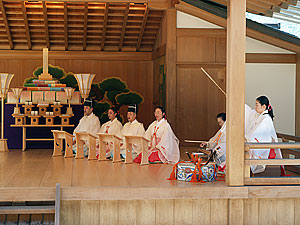
By Bill Roberts
KYOTO--The Rev. Mitsuyoshi Takeuchi, one of Japan’s top Shinto priests, believes the nations of the world could learn a lesson from the Japanese garden. In the garden, each tree, each stone, each waterfall has a reason to exist. They all respect each other and live in harmony. “The lesson of the garden,” says the Rev. Takeuchi, “is a lesson for the world. Just as the whole garden lives in harmony, the entire world must live in harmony.”
It is a lesson the Rev. Takeuchi has learned personally during the many interfaith activities of his long career as chief priest at Kamo Wakeikazuchi Jinja (Kamigamo Shrine) in Kyoto, Japan’s second most important Shinto shrine after the Grand Shrine of Ise near Nara. The Rev. Takeuchi says peace and harmony is a central message of Shinto: “The essence of the idea is to lead the world to a peaceful world. Harmony and respect for each individual. This is the model for peace. There is one world. One garden.”
Kamigamo Shrine itself is such a garden--a beautiful and very large one. Originally built around the time Kyoto became the capital of Japan in 794, it is the oldest Shinto shrine in the city. A serene refuge from the busy, upscale northern Kyoto neighborhoods nearby, Kamigamo is nestled in the forest at the southeastern foot of Koyama, the original mountain home of the deity enshrined there. A creek runs through the compound, resplendent in maple and gingko trees just beginning to turn red and gold on a bright cool morning in late October. The Rev. Takeuchi speaks with this writer through an interpreter in the office compound across from the shrine. A tall, graceful man, he often emphasizes his points with deliberate gestures from elegant hands.
A common perspective with Oomoto
With his message of peace and harmony, the Rev. Takeuchi sees the world much the same way Oomoto does. This common perspective is only natural given that Oomoto’s roots are deeply embedded in Shinto, an ancient indigenous religion which continues to exert enormous influence on the cultural values, spiritual attitudes and religious practices of 21st century Japanese.
Yet unlike most organized religions, including Oomoto, Shinto has no doctrine, scriptures or specific commandments. “The essence of Shinto is to go to a place, pray, have a quiet moment and get inspiration,” explains the Rev. Takeuchi. Shrines are crucial to this practice. Each of more than 100,000 shrines in Japan enshrines what Shinto followers believe to be an important holy spirit, usually from a nearby mountain, tree, stream or some other natural element. And each provides a serene place—a garden—in which to pray and contemplate. “By coming to a shrine and praying it gives us time to think about how we can lead our lives. There’s no dogma. No doctrine. No teachings. But there is a special holy spirit here,” he says.
Shinto grew from various folk beliefs and rituals that were held by the agrarian people of pre-recorded history in the Japanese archipelago. These beliefs and rituals, and the myths upon which they are based, have more in common with the beliefs of native Americans or Africans of pre-recorded history than they do with the major monotheistic religions that evolved in the past four thousand years.
Some people call these indigenous beliefs the “religion of the forest” because ancient life was so deeply rooted in the forest. It’s a phrase used often in official Shinto literature, which asserts the Japanese have long believed that the people, land, mountains, rivers and trees –in other words, all of nature--are offspring of the same deities, or kami. The ancient people made no distinction between themselves and nature. It’s a belief that continues in modern Shinto. “Trees, stones, water, earth and soil. They all have individual spirit,” says the Rev. Takeuchi. “And we respect each individual spirit.”
A bridge between one god and many
This thinking causes the Western mind to wonder if the ancient folk beliefs presaged modern scientific findings that all matter does indeed contain the same energy. Science has already discovered atoms and sub-atomic particles. Who’s to say there isn’t some as-yet discovered form of energy in everything—human, animate and inert objects—that is pure spirit. That would be an interesting twist on polytheism as understood by Shinto.
Oomoto in a way offers a bridge between the polytheism of Shinto and the strict monotheism of Judaism, Christianity and Islam. The revelations of Oomoto’s Foundress, Nao Deguchi, and Co-Founder, Onisaburo Deguchi, make one thing very clear: All beings have spirit and all spirit comes from the same source, the same origin—and that is the god of the entire universe.
Oomoto was one of many new religions that grew out of Shinto in the second half of the 19th century. These new religions are referred to as sect Shinto. The Rev. Takeuchi does not see them as being in conflict or competition with shrine Shinto. “We have different views,” he says. “But we can see the differences and respect them.”
This wasn’t always the case. Shinto went through a dark period, which began with the Meiji Restoration in 1868 and lasted through the end of World War II. The emperor was declared to be a god and Shinto became the official state religion to the exclusion of all others. Toward the end of this era, the Japanese government persecuted Oomoto, first in the early 1920s and again in the mid-1930s. After World War II, the new Japanese constitution separated church and state. What had been state Shinto became shrine Shinto as it is practiced voluntarily today.
Two wheels on the same cart
Those 77 years were not proud times for Shinto, the Rev. Takeuchi admits. He recalls the world outrage earlier this year when the Taliban government of Afghanistan destroyed centuries-old carved, stone Buddhas, and then points out that many more Buddhas were destroyed during the imperial era in Japan.
He reflects: “Shinto has always been tolerant of other religions, except from 1868 to the end of World War II. Today it is not unusual for a Japanese family to have both a Shinto shrine and a Buddhist temple in the home.” Buddhism is especially complementary to Shinto, he adds. He says Shinto is about how an individual values time now, in the moment, and Buddhism is about life after death. “We are two wheels of the same cart.”
Shinto has never spread beyond Japan, the Rev. Takeuchi says, because it has never had an evangelic mission. It doesn’t try to convert anyone. And he doesn’t believe it ever will. He does believe Shinto has an important lesson to teach about tolerance, harmony and respect. To this end, he has participated in many interfaith organizations and activities since early in his priesthood thirty years ago.
One such group is the World Congress on Religion and Peace, which includes leaders from Shinto, Buddhism, Christianity, Islam and many other religions. “We meet to have a dialogue, to try to transcend the different religions,” says the Rev. Takeuchi. “What Shinto offers is the idea of harmonious thinking. Respecting each. This idea itself will contribute a lot to the conflict we have now in the world or will have.”
In trying times like the ones in which we live, when radical fundamentalists from monotheistic religions use terrorism to try to prove the righteousness of their god, Shinto and spin-offs like Oomoto offer a message of tolerance for all gods or ways of the spirit. As ancient as this belief may be, it seems more essential to global peace now than ever.
 The Rev. Mitsuyoshi Takeuchi, head of Kamigamo Shrine, and the writer, Bill Roberts.
The Rev. Mitsuyoshi Takeuchi, head of Kamigamo Shrine, and the writer, Bill Roberts.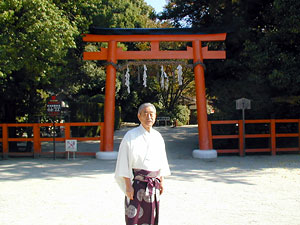 The Rev. Mitsuyoshi Takeuchi outside Kamigamo Shrine.
The Rev. Mitsuyoshi Takeuchi outside Kamigamo Shrine. 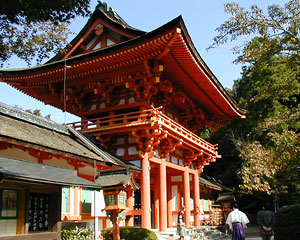 Main entrance to Kamigamo Shrine
Main entrance to Kamigamo Shrine A creek runs through the Kamigamo Shrine
A creek runs through the Kamigamo Shrine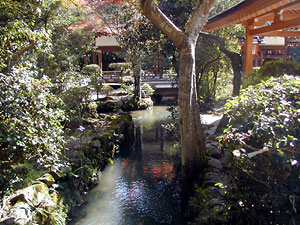 The grounds of Kamigamo Shrine are like a garden.
The grounds of Kamigamo Shrine are like a garden.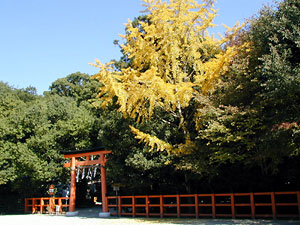 Gingko tree in full color at Kamigamo Shrine.
Gingko tree in full color at Kamigamo Shrine.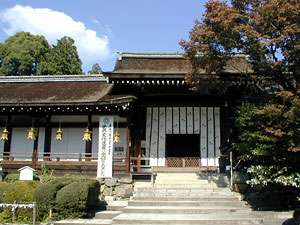 Entrance to the inner shrine.
Entrance to the inner shrine.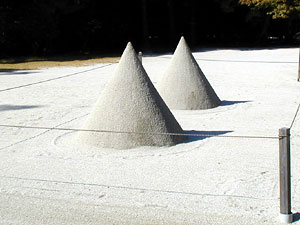 Two mounds of gravel, carefully sculpted, symbolize the mountain from which Kamigamo's deity descended.
Two mounds of gravel, carefully sculpted, symbolize the mountain from which Kamigamo's deity descended. The outer yard at Kamigamo Shrine.
The outer yard at Kamigamo Shrine.New Contents Thu, May 20, 2010
- Oomoto participates in Sant’Egidio conference : Dialogue among religions and cultures : On divided island nation of Cyprus By Bill Roberts
- Photo Album : Portraits of three branches: Shoko, Tanegashima and Aomori By Bill Roberts
- Oomoto FAQ
- A Letter from Oomoto : Of mountains and myths By Bill Roberts
- Polyglot poem festival The Utamasturi is going international — what’s next? By Bill Roberts
- Ethics education program captures the spirit of Bankyo Dokon By Bill Roberts
- A Letter from Oomoto : A year’s worth of adventure in a summer of branch visits By Bill Roberts
- In Kumamoto, it’s all about water – and fire By Bill Roberts
- A speech by Nevada Taylor at the Kii Branch in Wakayama Prefecture on April 13, 2008.:An Encounter With Oomoto Through Aikido
- Utamatsuri, Poem Festival, in Tokyo(on April 17, 2008)
- A speech by Neil Ryan Walsh at the Kobe branch on Mar. 9th, 2008.:Planting the Seeds of the Soul
- Meeting with the Fifth Spiritual Leader of Oomoto, Madame Kurenai Deguchi by Neil Ryan Walsh
- A speech by Neil Ryan Walsh at the Nagoya branch on Feb. 17th, 2008.:The Japanese Arts beyond National Boundaries
- To the Oomoto branch in Nagoya: City of Eel and Toyota by Neil Ryan Walsh
- A Speech by Nissim Ben Shitrit, Ambassador of Israel on the occasion of the Oomoto Setsubun Grand Festival in Ayabe February 3rd, 2008 : Japan and Israel : Two Lands Balancing the Needs of Traditional Culture and Modern Life. r
- A permanent memorial to Onisaburo (A Speech at the Autumn Grand Festival , November 6, 2007 : )By James Parks Morton, Founder and Chair, Emeritus of The Interfaith Center of New York
- Israel, Palestine and the Power of Poetry(Oomoto believes small efforts can have lasting ripple effects on people and peace)By Bill Roberts
- “Something Great”(This genetics pioneer, a friend of Oomoto, offers a clue to the mystery of life)By Bill Roberts
- Kamishima Cleanup (Harima branch members regularly visit this sacred island to keep the shrine tidy)By Bill Roberts
- Kyotaro Deguchi was one of six recipients of the 2007 James Parks Morton Interfaith Award
What is Oomoto?
- What is Oomoto?
- Spirtual Centers
- Founders and Spiritual Leaders
- History
- Organization and activities
- Teachings and scriptures
- Art Works of Founders and Leaders
Opinions[Archive]
- Statement of regret for the outbreak of war against Iraq (March 20,2003)
- Jinrui Aizenkai dispatched the "Urgent Appeal for a World (Global) Crisis" on March 14.
Grappling with Bioethics[Archive]
- Oomoto’s support for abolishing the death penalty (12, June 2003)
- The Oomoto Foundation protests any birth of a human clone baby. (5, January 2003)
- OOMOTO'S VIEW REGARDING JAPAN’S PERMITION TO THE RESERCH OF HUMAN EMBRYONIC STEM CELLS (ES cells)(12, June 2000)
Vistor’s Review[Archive]
- A speech by Bill Roberts at the Oomoto branch in Hiroshima after its monthly service on March 18, 2007:Encounters with war and peace
- How Bankyo Dokon changed one life by Linda Macphee
- A speech by Bill Roberts at the Hokuriku (Kanazawa) branch on Dec. 3, 2006:Ritual and myth -an encounter with ‘divine madness’
- A speech by Bill Roberts at the Himeji Cultural Center on Feb. 25, 2007:Mesmerized by the Japanese Arts
- A speech by Bill Roberts at the Kobe branch on Feb. 11th, 2007.:There are just human tears and human joy
- A Speech on the occasion of the Oomoto Setsubun Grand Festival in Ayabe February 3rd, 2007 : Egypt's role in Middle East peace
- Keynote Speech for the 28th World Federation Japanese Religionists Conference for World Peace in Tokyo (at Kokugakuin University, Novermber 29, 2006):Vision for Peace in the Middle East By Dr. Munther S. Dajani, Professor Dean, Faculty of Arts, Al Quds University, Jerusalem
- A speech to the Kyoto branch:Spiritual adventures in researching Oomoto leaders
- A Speech at The Oomoto Foundation on Monday, November 6, 2006 : Jordan's role in Middle East By Samir Nouri, Ambassador of the Hashemite Kingdom of Jordan
- A letter from Oomoto:The Young People of Tottori
- A speech by Bill Roberts on the occasion of the dedication ceremony for the new shrine of Tottori Branch By Bill Roberts Oct. 8, 2006
- A speech by Bill Roberts at the Oomoto branch in Hiroshima after its monthly service on March 18, 2007:Encounters with war and peace
- How Bankyo Dokon changed one life by Linda Macphee
- A speech at Setsubun : A Portrait of Oomoto By Bill Roberts Feb. 3, 2006
- New Publication ! By Bill Roberts Feb. 3, 2006 A Portrait of Oomoto
you can read this book in html => http://www.jinruiaizenkai.jp/English/en-kolumno/en-bill/en-sugao/billbook1en.html
E-mail below to order brobert1@ix.netcom.com
Current Topics
- Prayer Offering and World Religious Forum II
- Living the art of dialogue
- Kyotaro Deguchi was one of six recipients of the 2007 James Parks Morton Interfaith Award
Books
Online Books
- Divine Signposts by Onisaburo DEGUCHI
- The Creation of Meaning by Hidemaru Deguchi
- Bankyo Dokon(Seventy years of Inter-Religious Activity at Oomoto)
- Nao Deguchi — A Biography of the Foundress of Oomoto
- The Great Onisaburo Deguchi published by Aiki News
- Bankyo Dokon Seventy Years of Inter-Religious Activity at Oomoto
- Insearch of Meaning
- Nao Deguchi A Biography of the Foundress of Oomoto
- A Portrait of Oomoto By Bill Roberts
Oomoto international Archive
- The History of Oomoto (Jan.– Mar. 1980 — Apr.– Jun. 1982)
- The Ancestors; Friends or Foes? (Apr.– Jun. 1987)
- Tsukinamisai; The Sabbath of Shinto (Jan.– Jun. 1983)
- The Poem Festival at Oomoto; An Ancient Rite Lives Again (Oct.– Dec. 1981)
- Purification of the Universe ; Oomoto's Setsubun Festival (Apr.– Jun. 1981)
Links
Flowers at Ten'on-kyo & Baisho-en (photographs)
Contact
All rights reserved : the Oomoto Foundation Produced by the Netinformational Commission
Since : Mar. 7.1998 Last Update : Thu, May 20, 2010
E-mail : webmaster@oomoto.or.jp
Top Page Nihongo Esperanto Português Roomazi



